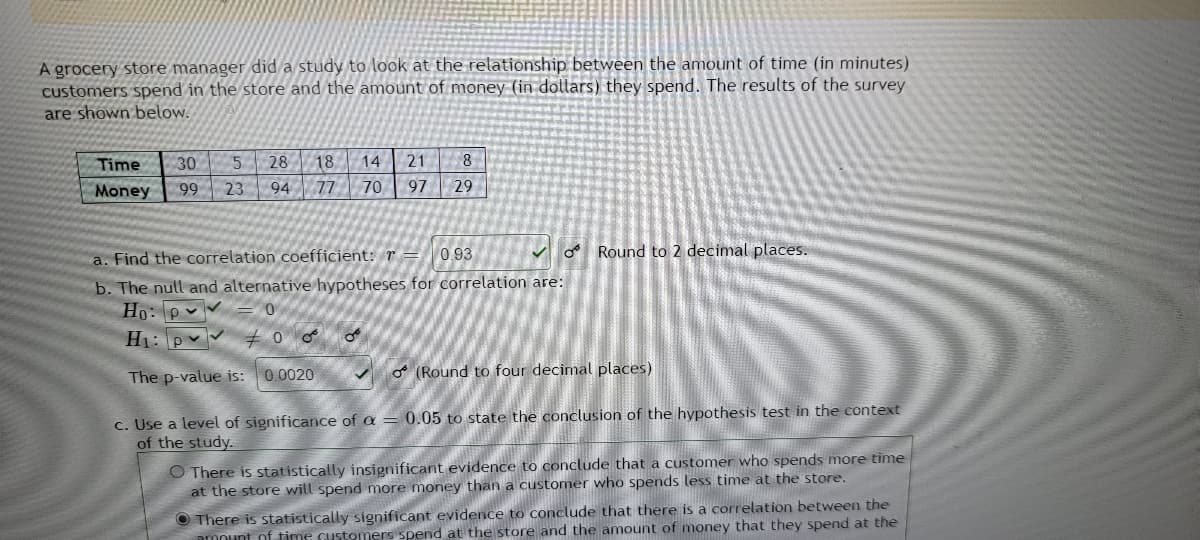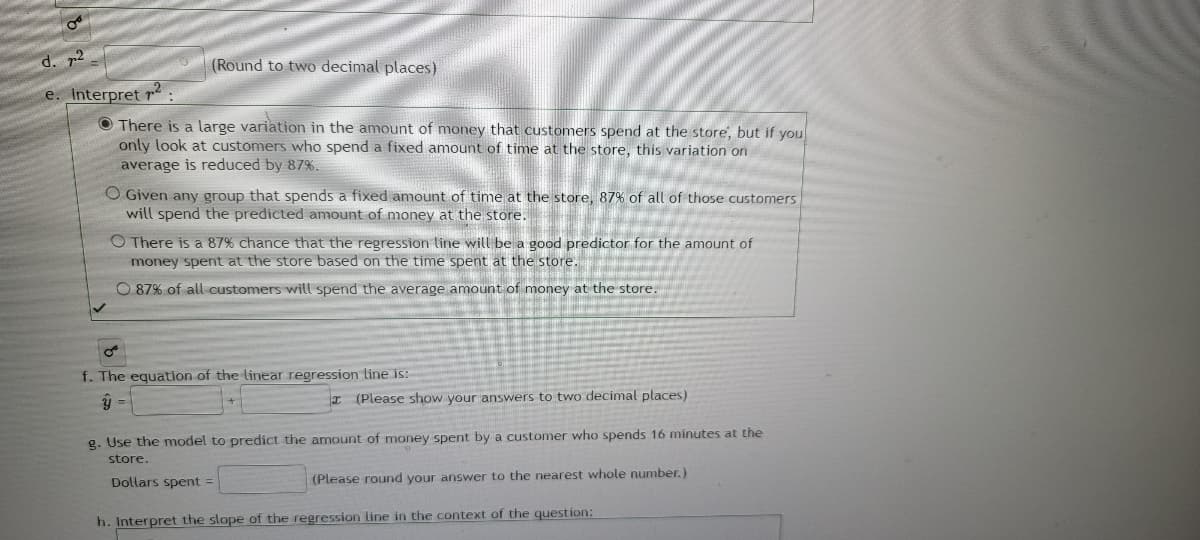A grocery store manager did a study to look at the relationship between the amount of time (in minutes) customers spend in the store and the amount of money (in dollars) they spend. The results of the survey are shown below. 14 21 8 Time Money 30 5 99 23 28 18 94 77 70 97 29 a. Find the correlation coefficient: r = 0.93 ✓ Round to 2 decimal places. b. The null and alternative hypotheses for correlation are: Ho: p H₁: p 00 of The p-value is: 0.0020 (Round to four decimal places) 0.05 to state the conclusion of the hypothesis test in the context c. Use a level of significance of a of the study. O There is statistically insignificant evidence to conclude that a customer who spends more time at the store will spend more money than a customer who spends less time at the store. There is statistically significant evidence to conclude that there is a correlation between the amount of time customers spend at the store and the amount of money that they spend at the
A grocery store manager did a study to look at the relationship between the amount of time (in minutes) customers spend in the store and the amount of money (in dollars) they spend. The results of the survey are shown below. 14 21 8 Time Money 30 5 99 23 28 18 94 77 70 97 29 a. Find the correlation coefficient: r = 0.93 ✓ Round to 2 decimal places. b. The null and alternative hypotheses for correlation are: Ho: p H₁: p 00 of The p-value is: 0.0020 (Round to four decimal places) 0.05 to state the conclusion of the hypothesis test in the context c. Use a level of significance of a of the study. O There is statistically insignificant evidence to conclude that a customer who spends more time at the store will spend more money than a customer who spends less time at the store. There is statistically significant evidence to conclude that there is a correlation between the amount of time customers spend at the store and the amount of money that they spend at the
Glencoe Algebra 1, Student Edition, 9780079039897, 0079039898, 2018
18th Edition
ISBN:9780079039897
Author:Carter
Publisher:Carter
Chapter4: Equations Of Linear Functions
Section4.5: Correlation And Causation
Problem 2CYU
Related questions
Question
Need help with, d,f, and g and the answer is not 0.86 or 0.92^2

Transcribed Image Text:A grocery store manager did a study to look at the relationship between the amount of time (in minutes)
customers spend in the store and the amount of money (in dollars) they spend. The results of the survey
are shown below.
21 8
Time 30 5
Money 99 23
28 18. 14
94 77
70
97
29
a. Find the correlation coefficient: r
0.93
Round to 2 decimal places.
b. The null and alternative hypotheses for correlation are:
Ho: p
0
H₁: p
#00 O
The p-value is:
0.0020
(Round to four decimal places)
c. Use a level of significance of a = 0.05 to state the conclusion of the hypothesis test in the context
of the study.
O There is statistically insignificant evidence to conclude that a customer who spends more time
at the store will spend more money than a customer who spends less time at the store.
There is statistically significant evidence to conclude that there is a correlation between the
amount of time customers spend at the store and the amount of money that they spend at the

Transcribed Image Text:d.
2
e. Interpret ²
(Round to two decimal places)
There is a large variation in the amount of money that customers spend at the store, but if you
only look at customers who spend a fixed amount of time at the store, this variation on
average is reduced by 87%.
Given any group that spends a fixed amount of time at the store, 87% of all of those customers
will spend the predicted amount of money at the store.
O There is a 87% chance that the regression line will be a good predictor for the amount of
money spent at the store based on the time spent at the store.
O 87% of all customers will spend the average amount of money at the store.
o
f. The equation of the linear regression line is:
y =
x (Please show your answers to two decimal places)
g. Use the model to predict the amount of money spent by a customer who spends 16 minutes at the
store.
Dollars spent =
(Please round your answer to the nearest whole number.)
h. Interpret the slope of the regression line in the context of the question:
Expert Solution
This question has been solved!
Explore an expertly crafted, step-by-step solution for a thorough understanding of key concepts.
This is a popular solution!
Trending now
This is a popular solution!
Step by step
Solved in 2 steps with 2 images

Recommended textbooks for you

Glencoe Algebra 1, Student Edition, 9780079039897…
Algebra
ISBN:
9780079039897
Author:
Carter
Publisher:
McGraw Hill

Glencoe Algebra 1, Student Edition, 9780079039897…
Algebra
ISBN:
9780079039897
Author:
Carter
Publisher:
McGraw Hill